First Day at the Jungle Lodge
4 October, 2007, 01:43 pm in "Peru"
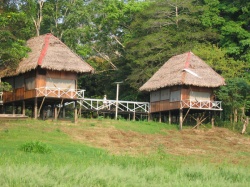 Morning on the lake seems so quiet compared to all the noises of the night: insects, generators, bats, frogs. The lake is still with just an occasional fisherman going by. Birds hover, call and dive into the water. Across from us is a quiet green forest. The lake is low so below the trees is a marshy area of light green grass. This isn't as overwhelming as I thought the jungle would be. Of course, it isn't old growth and it isn't deep in the jungle. It is just a taste. The lake looks silver, reflecting a gray sky.
Morning on the lake seems so quiet compared to all the noises of the night: insects, generators, bats, frogs. The lake is still with just an occasional fisherman going by. Birds hover, call and dive into the water. Across from us is a quiet green forest. The lake is low so below the trees is a marshy area of light green grass. This isn't as overwhelming as I thought the jungle would be. Of course, it isn't old growth and it isn't deep in the jungle. It is just a taste. The lake looks silver, reflecting a gray sky.We had a good night's sleep after a busy day. Lalo, our guide picked us up at the hotel and took us by taxi, then by long wooden motor boat to the lodge. After we left our luggage in the bungalow, we got back in the boat and went a little farther up the lake, passing frolicking freshwater dolphins on the way, to a trail called the Ayuhausca Botanical Garden. The property is owned by a man named Victor whose cousin is a shaman. Victor lives in a wooden house on stilts near the lake. Since it was the dry season, flocks of chickens ran around underneath the house. Victor had 2 spider monkeys on ropes tied to trees and a squirrel monkey who usually did not have to be tied but had tried to run off with a band of wild monkeys that morning.
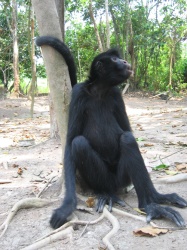
The ropes were secured loosely to the trees so the monkeys were able to climb but it still was sad to see them tied there.
We set off on the trail passing by a series of huts that were used for healing. Lalo said if someone was sick, first they'd take Ayuhuasca to cleanse the body and purify the blood. Then the shaman would prescribe treatments and the sick person would stay in the houses for sometimes as long as 8-12 weeks.
Lalo pointed out various healing trees and plants as we went. The first, Catawa, was poisonous so he carefully dug his machete into the bark and let the white latex drip down. He explained the sap would make your skin swell up. However, if you were ever bitten by a snake, the root and bark could be used to prevent the poison from spreading. Some of the tribes used it to stun fish.
For most of the other trees he showed us, he would whack the bark with the machete letting the sap drip down like blood. There were lots of slashes in the bark where other people had harvested the sap. During the rainy season the area we were walking would be under about 8 feet of water. People would access the trees by canoe.
We also looked at a lot of insects. Everywhere there were huge termite nests and trails up the sides of trees (covered tunnels built by the termites with the same material they used for their nests). On one tree, Lalo poked a hole in the mound. The tiny termites swarmed to the outside of the nest to fix it. Lalo placed his hand on the mound and the termites covered his hand. As he crushed the termites on his arm, he explained this was the jungle's natural mosquito repellent. Rowshan let them cover his hand and I squished them onto his hand, rubbing them onto my arm (they were so tiny it felt more like rubbing sand around then gross bug squishing). The termites actually smell a lot better than bug repellent... kind of woody. We weren't able to judge the effectiveness of the termites as repellent since we'd already sprayed DEET on our skin. DEET does not deter termites....
A little farther down the path was a huge ant nest made of dried leaves hanging on a tree. We stood next to it and as soon as Lalo began to talk, the ants heard him and swarmed to the outside, covering the nest with their black crawling bodies.
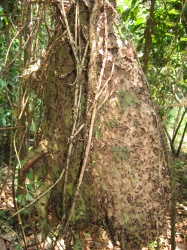
Another tree, the tangarana, was hollow and the home of tangarana ants whose bites could give you a fever for several hours. Lalo said he'd heard some tribes use cutting a piece from a tangarana tree as a way to test the strength and marriageability of a young man, since touching the tree caused the ants to swarm and attack.
A very interesting vine is called the Cat's Claw because of the thorns on it that look like cat's claws. Large amounts of the bark are being exported to the US because it is being studied as a possible cure for both cancer and HIV. Before that most people treated it as a weed, though now many locals drink it. Lalo cut a piece of the vine and we were able to drink water from it. People were now cultivating the vine.
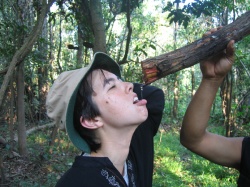
At the base of another tree we saw a nest of bullet ants. They were about an inch long and had nasty pinchers. They are very poisonous. Another tree had a hollow filled with little black bats.
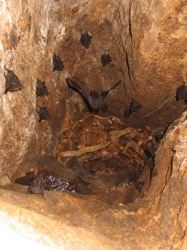
We walked through a field with corn and other plants. Lalo pulled up a purple flowering plant and said he saw a woman gathering it in town and had asked her why. She said it was keeping her sister alive. The woman had been diagnosed with cancer and told by the doctor she only had a few months to live so she went home to be with her family. Someone told her to drink a tea from this plant and the tumor had gotten smaller. When the doctor saw her he was surprised that not only was she alive but she'd gotten healthier. Lalo said everyone else treated the plant like a common weed. One of the amazing things about the jungle are there are so many things we don't know about it. There are so many plants, each with unique properties. Maybe the woman just got lucky but maybe this common Amazon weed will one day reveal a cure for cancer.
We looked at some more trees then went back to the lodge for a meal of cod, fried plantains and noodle looking things which we learned were actually heart of palm. We had a pitcher of fresh juice from kokona, a fruit with massive amounts of vitamin C which tastes a bit like pineapple and orange mixed.
Then we we went in the boat to another part of the lake for an early evening walk. The purpose of the walk was to find sloths who liked to hang out in the trees in this area. We saw one high up in a tall tree. Lalo said he wanted to find one in a smaller tree and cut it down so we could take photos. I objected but got ignored. Rowshan thought he was just going to scare it so it came down. Secretly, I hoped we wouldn't find any more. However, soon an unfortunate victim in a smaller tree was found. The branch was chopped down and Lalo pulled out the sloth and passed her to me. It was such a tragic creature with sweet sad tired looking eyes and slow sleepy movements, long arms and 3 big claws. I was glad to see we managed not to injure it (I had this overwhelming fear we'd end up with a dead sloth on our hands.) After we finished harassing the sloth. We placed it back in one of the remaining branches of its tree and it slowly climbed back up. After meeting the sloth, Rowshan felt really bad for it too.
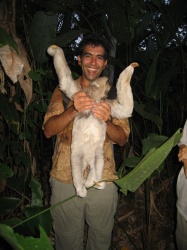
It was getting dark when we reached the shore where the boat was going to pick us up. Since it was too shallow for the boat, we had to wade across a muddy opening of what during the rainy season is a canal leading to the Ukayali River. In the brief time between zipping off my pant legs and getting them back on in the boat, my legs got covered with mosquito bites.
Boating back to the lodge, the shores were dark except for occasional flickering fires and an occasional light from a house. Fireflies flashed like green sparks above the water.
Back at the lodge we had a huge dinner and then went to our bungalow. Rowshan went into the bathroom and exclaimed "OH MY GOD!!!" then started laughing and calling for me to come look.
"Come quick! I thought it was something that didn't flush but it's a frog!" I rushed into the bathroom and looked into the toilet but didn't seem anything. We flushed the toilet a couple times but still nothing. Rowshan insisted that it was there so later that night we checked again. There inside the toilet, clinging to the edge of the bowl was a big fat brown toad. It dropped down into the water and Rowshan flushed him.
In the morning I went to use the toilet and when I flushed, the toad once again was clinging to the edge of the bowl where the water came down. We named the toad "Mr. Hanky" after the South Park character.
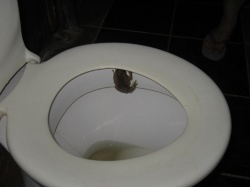
Rowshan also found a little frog in his bag. We weren't sure if it was one of the poison dart frogs. It was brown but had bright red feet and was the size of a poison dart frog. Rowshan herded it outside with my flip flops.
[ View 1 Comments
|
]
Comments
esther o-c -
posted on 10/31/2007
Nice photo, enduring toad
Powered by My Blog 1.69. Copyright 2003-2006 FuzzyMonkey.net.
Created by the scripting wizards at FuzzyMonkey.net..
(Code modified by Rowshan Dowlatabadi)
Created by the scripting wizards at FuzzyMonkey.net..
(Code modified by Rowshan Dowlatabadi)

